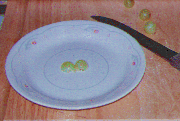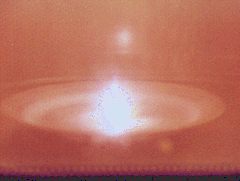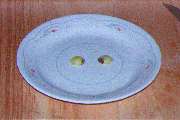Fun with Grapes - A Case Study
Last Updated: 14 June 1994
Author
Patrick R. Michaud, pmichaud@pobox.com
Abstract
Using only cheap, readily-available equipment, you can create a
spectacular lightshow in the comfort of your very own kitchen,
providing hours of fun and excitement for your family, friends,
and pets!
Ordinary grapes, when properly prepared and microwaved, spark
impressively in an extremely entertaining manner.
Introduction
We have made an important new discovery in the field of
culinary entertainment. Properly prepared, the common seedless
grape can be made to combust spectacularly when subjected to
a short (5-10 second) duration of microwaves. This study was
conducted based upon suggestions from dozens of IRC #root
participants using locally available funds and equipment.
Materials Required
The following materials were needed for this study:
- Green grapes (genus Vitis)
- Microwave-safe plate (Corelle by Corning)
- Knife (Ekco Stainless Steel)
- Microwave Oven (Whirlpool Model MT6901XW-0)
- No parental sponsors (both authors are fortunate to have
supporting funds unencumbered by parental restrictions)
Procedure
- The authors carefully cleared the laboratories of
all non-essential personnel, especially those persons who
might attempt to abort the experiment while the grapes were
still in the pre-combustion phase.
- Next, the grapes were carefully prepared for proper
theatrical effect. The knife was used to carefully slice the
grape almost in half, leaving the grape halves attached by
the skin. Next, the grapes halves were placed face down in
the middle of the microwave safe plate (Figure 1).

Figure 1. Grape prepared for theatrical effect
- Next, the plate with the prepared grapes were placed into the
center of the microwave oven and the door carefully shut. The
microwave was set to cook at full power for 40 seconds. Finally,
after the various recording devices were in place, the
start button on the microwave was engaged.
Observed Results
As can be seen from figure 2, the effect of the microwaves on the
sliced grapes produced an extremely satisfying flare and associated
sparks. The photographic quality of figure 2 is slightly
deteriorated due to the poor lighting conditions at the time of
the experiment.

Figure 2. Theatrical effect
The sparks began approximately 5 seconds after the microwave
was started. Approximately 3-4 seconds after that, the force
of the sparks separated the grape halves by approximately 1.5 cm,
ending the theatrical effects. At that point the microwave session
was aborted to prevent further damage to the microwave and/or grape.
The post-combusted grape is shown in figure 3.

Figure 3. Post-theatrics grape.
Discussion and Conclusions
As this report was being prepared, it became evident to the
researchers that a mis-communication occurred from the
experimental design to the actual conduct of the experiment.
The original experimental design called for the grapes to be
placed on the plate with the sliced side up, whereas this
experiment occurred with the sliced sides placed downward.
Further research will be required to determine if the
positioning of the grapes significantly affects the theatrical
results.
A future experiment calls for the microwaving of multiple
grapes simultaneously for increased theatrical effect. For
those who wish to forge ahead on this research, the authors
suggest separating each grape by a distance of 1.5 cm or more.
Note that the authors take no responsibility for any accidents
resulting from mis-application of this study. If your
microwave blows up and your house catches fire, call the
fire department, not us. Our microwave ovens appear to be
in good shape after repeated experiments.
The results of this study will greatly enhance the field
of culinary entertainment. New pyrotechnic methods have been
developed using commonly available grapes and microwave ovens.
The results of this study and its derivative works provide
fertile ground for new research. The authors are planning to
use this research as a basis for experimentation with other
species of grape and produce. Results of such study will be
made available in future publications.
Acknowledgements
The authors gratefully acknowledge the operators of IRC and
the participants of channel #root, without whom this study
would have been left incomplete.
Patrick R. Michaud/pmichaud@pobox.com


